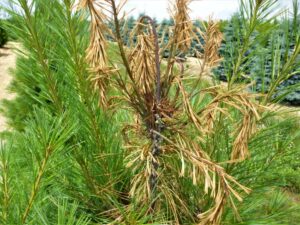The accumulation of heat units (Growing Degree Days (GDD) will soon begin to increase rapidly in New Jersey as we approach the early weeks of April. If past histories or present-day monitoring indicate the need for interventions, then the best control windows for numerous insect/mite pests are beginning to occur. The following is an incomplete listing of a handful of some of our early-season Christmas tree insect pests that may need to be scouted & possibly controlled. Those included in this blog are the European pine sawfly, Eastern spruce gall adelgid, Cooley spruce gall adelgid, Nantucket pine tip moth, Pales weevil, White pine aphid, & Pine bark adelgid.

After many years, these slow growing Colorado blue spruce trees are close to reaching their peak selling growth stage as Christmas trees. (Photo Credit: Steven K. Rettke, Rutgers Coop. Ext.)



